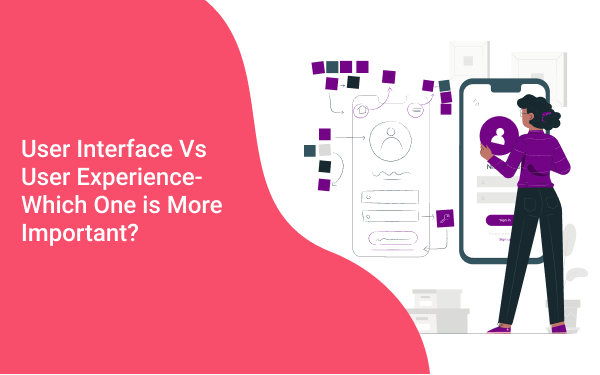User Interface Vs User Experience- Which One is More Important?
User Interface (UI) and User Experience (UX) are the two confusing terms that are often used in place of each other, but are different at the core level. If we look closely, UI in design is focused more on facilitating usability, while UX is a broader term that considers a combination of cognitive behavior and human interaction with the design.
Quick Links
A designer who is at the beginner level or doesn’t understand much about these two crucial aspects of designing, we are here with the details. In this blog, we will discuss what UI and UX mean, what is the core difference between the two, and what is more important?
So, let’s begin!
What is UI?
UI in designing refers to the design for software, websites, and applications with a utilitarian approach to facilitate functionality and usability that allows users to interact. You might have gone through numerous websites, and would have seen some random forms available on every website. Those forms or websites are called UI as they have various elements through which you take action or enter your data.
Supposedly, you are to fill a company’s contact form, the user interface here would consist of text boxes, a drop-down list, a button, and other components. This specific design will allow you to enter your data in the form and it is called a user interface.
Here are a few properties of a well-designed UI:
- Crystal clear elements
- Consistency to facilitate easy recognition of usage pattern
- Efficiency and productive interaction
What is UX?
UX refers to the user experience in designing that focuses on the cognitive and general aspects of the human behavior through which anyone will interact. The concept of UX evolved with the need to make improvements in the UI. This way, the users can have a positive and satisfactory experience while interacting with numerous elements on a web page at once.
User experience encompasses major aspects of the end-users interaction with the website, application, or software. For instance, you visit a website and web design feels scrambled without any direction, it may frustrate you a bit. On the other hand, another website that has an intuitive design that directs you what to do next just after a glimpse, you will feel motivated to take action. This is the power of user experience which is followed by a great user interface.
What is the Fundamental Difference Between UI and UX?
If we talk about the major difference between UI and UX, then we have already discussed a few points in the above section pointing towards the inclusiveness of the term user experience. UI considers the design aspect or the usability of the design, while user experience considers the force behind human behavior and the way users interact with that design.
Technically, “UI is how good a website looks and UX is how good you feel while using the website.” A user interface would relate to the white spaces on the website, color schemes and contrast, images, Call-to-actions, and other crucial elements that make up a website. Moreover, a skilled UI designer would ensure that the user interface looks good on all devices.
Now, UI is just a part of the UX design process that includes research, brainstorming, implementation, and reporting. Here research can include numerous things like identifying requirements, understanding user persona to identify trigger points, use cases, and journey maps as to how a user would go about from start to end.
Brainstorming would include user flow and wireframes, which are rough presentations of the UI. Implementation of UI is actually the part that we talked about above, which includes prototyping and frontend and backend development. Next in UX comes reporting that includes usability reporting, split tests, and analytical reporting.
We can say UX is a process while UI is just a step in the entire process that contributes to the design. Well, this make UX more important than UI?
Let’s get straight to the point.
Is UX Crucial than UI?
Yes, UX has an upper hand over UI as it recognizes the implied needs and pain points of the users by analyzing user persona and user journey maps. It resonates with users’ needs and creates an experience that improves the quality of time spent on a website or an application. UX helps to cover multiple touch points by considering several questions around how a user would feel while browsing a website. These questions could be:
- How will a user discover your products and services?
- What could be the sequence of action or route they would take while interacting with the UI?
- What would be the thoughts and feelings of the user while he is browsing the website?
- What impression they would carry while browsing the website?
If you ask what makes a good UX design then here is a visual pyramid that depicts the users’ needs and could be a great reference for UX designers during the entire UX designing process.
Since UX is the core factor to be considered while designing that influences human behavior, then it is crucial to know what psychology works behind users’ interaction?.
What is the Psychology behind UX?
A UX designer would design for a website or an application to elicit specific responses and actions from your target users. But, there are a few psychological principles that one must consider in the process.
The Von Restorff Effect was a principle coined by Hedwig Von Restorff focused on making an element distinctive from the rest. This is the reason it is also called the Isolation Effect. When something distinct appears on the screen always catches the attention of the users. So, always ensure that you include distinct and unique elements that are easy to remember.
Another great principle that you must consider is the serial positioning effect, which was coined by Herman Ebbinghaus that focused on the position of items and elements. When users browse your website, they have the propensity to remember what they saw first and last. Thus, UI/UX designers are required to place the crucial information first and last and the less important in the middle. It will garner great attention from the users.
Cognitive load is another parameter to consider for UX design. If you don’t know what it is, then let us tell you that it has much to do with the mental effort that someone puts to complete a task. You can call it an amount of thought that the user would need to use while completing a task. Make sure you keep the load bare minimum so the user doesn’t get tired and is motivated to complete a task.
Apart from this, Aesthetic-Usability Effect is to be considered that focuses on the positive emotional response to the visual design and keeping a balance of functionality and aesthetics.
What Matters When it Comes to Hiring UI/UX Designers?
Despite the major difference in the practical application of both UI and UX, they are the areas to skimp on. The reason is that UI and UX are both the crucial parts of the designing process as the customer only spends the money when he gets a satisfactory experience. Here one thing that is of prime importance that makes for a major difference is the source from where you take the services. The source from where you take designing services is crucial in terms of technology and approach. You must ask them how they keep abreast of the UX/UI design theories and practices? Considering that customer experience is now the key differentiator factor between competitors across all industries, your UX can literally make or break your company’s success during the design process. The best UX researchers and auditors rely on powerful software to help them uncover trends, find funnel drops and collect user sessions 24/7.
Apart from this, other parameters also contribute to the success of the designing project. If you take the help of a company, then they have all the resources and can spend more time on improving the UX. On the other hand, if you work with a freelancer, they are a “one-man show” who works with the sheer wisdom they have got from the industry and their experience. If you are looking for someone to help you exclusively in the entire designing process right from research and brainstorming to implementation and report, consider working with a designing company.

Author Bio, Sidharth Jain, Proud Founder of Graffersid, Top UI UX designing company based in India. Graffersid has a team of designers and dedicated remote developers, Trusted by startups in YC, Harvard, Google Incubation, BluChilli. He understands how to solve problems using technology and contributes his knowledge to the leading blogging sites.
How to Use AI-Powered SEO Tools for WordPress eCommerce
SEO is a critical factor in the success of any e-commerce WordPress store. As competition…
0 Comments11 Minutes
Why Short-Form Videos Are the Future of Content Marketing
Your Instagram customers spend over 50% of their time watching short-form videos and reels. Rather…
0 Comments12 Minutes
The Role of Digital Marketing in Business Growth
Online marketing touches every aspect of a business, whether it is initiating the idea or for an…
0 Comments3 Minutes
AI Meets Authenticity: Balancing Automation and Human Touch in Content Marketing
Is your brand starting to sound like a robot? In a world where algorithms write faster than any…
0 Comments8 Minutes
Essential Tools for Enhancing Web Design and UX Hosting
Have you ever visited a website that felt slow, clunky, or confusing? A website that is poorly…
0 Comments11 Minutes
How a Mini Cart Transformed My Store’s Shopping Experience
Okay, real talk—running an online store is hard. You think you’ve got everything figured out, you…
0 Comments9 Minutes
Balancing Your Security Initiatives With Industry Compliance Requirements
Managing a business today comes with a number of daily battles that need to be fought. Resources…
0 Comments11 Minutes
Best plugins to enhance the customer shopping experience
Customer experience is a key part of every online store. A good experience helps customers find…
0 Comments7 Minutes








